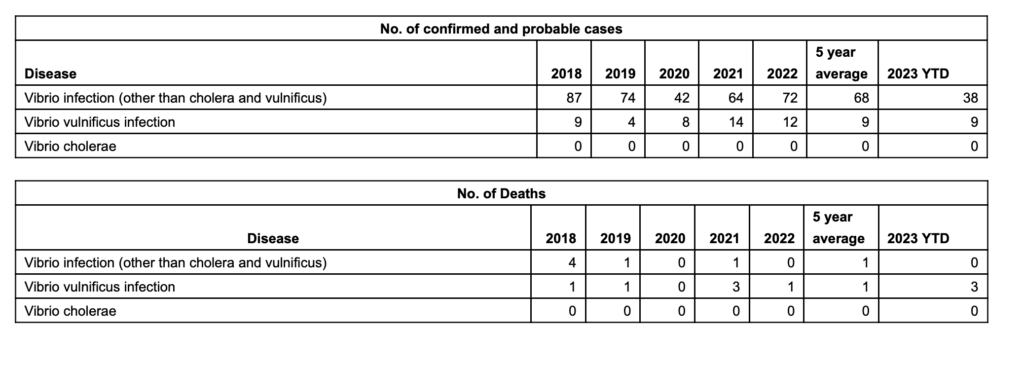Infection
Three North Carolinians have died from Vibrio infections this year, all in July; DHHS issues precautions
Three North Carolinians have died from Vibrio infections so far this year, according to state health officials, representing a third of those who have been infected.
Vibrio are naturally occurring bacteria that live in warm seawater or brackish water (mixed salt and fresh water, as is found in an estuary or salt marsh) and can be found worldwide. Since they are naturally found in warm waters, people with open wounds, cuts or scratches can be exposed to these bacteria through direct contact with seawater or brackish water, according to the NC Department of Health and Human Services. Vibrio can also cause disease in those who eat raw or undercooked oysters and shellfish.
There are several types of Vibrio bacteria, with Vibrio vulnificus presenting the highest risk. However, exposure to all forms of Vibrio can cause serious illness or death.
NC Newsline reported on two of the fatalities earlier this week. One man, Michael Gerd, cut his hand on a crab pot and died last week, according to the Outer Banks Voice.
While healthy individuals typically develop mild illness, Vibrio infections can be severe or life threatening for people with weakened immune systems or chronic liver disease. If you start to see signs of a skin infection after contact with brackish waters or seawater, you should contact your health care provider. Other symptoms can include diarrhea, stomach pain, vomiting, nausea, fever and chills, according to DHHS.
Here are the most recent numbers, as compiled by DHHS:
- Since 2019, eight of the 47 reported Vibrio cases among North Carolina residents have been fatal — about 18%.
- The three most recent fatalities have occurred in July 2023. Two of the three cases had scratches that were exposed to brackish water in North Carolina and another East Coast state.
- The third case also had brackish water exposure in North Carolina, however, the individual also consumed personally caught seafood that was not shared nor commercially distributed.
- No links have been identified between the cases or the areas where they were likely exposed to Vibrio, and public health investigations are ongoing. No other information about the decedents will be shared at this time due to privacy concerns.
The chart below lists the types of Vibrio infections reported in North Carolina to public health officials. For Vibrio vulnificus, the number so far in 2023 has met the five-year average, with several warm months ahead. The number of deaths this month equals that of all of 2021.
Following these recommendations will help reduce your likelihood of exposure and infection, according to DHHS:
- If you have a wound (including from a recent surgery, piercing or tattoo), stay out of saltwater or brackish water, if possible. This includes wading at the beach.
- Cover your wound with a waterproof bandage if it could come into contact with saltwater, brackish water or raw or undercooked seafood.
- If you sustain any type of wound while in salt or brackish water (e.g., cutting your hand on a boat propeller or crab pot) immediately get out of the water and wash with soap and water.
- Wash wounds and cuts thoroughly with soap and water after contact with saltwater, brackish water or raw seafood.
- Thoroughly cook all shellfish to an internal temperature of at least 145 degrees for 15 seconds, according to the U.S. Department of Agriculture.
Vibrio cases are expected to increase as climate change heats the oceans, lengthening the seasons when the bacteria can thrive — and extending the bacteria’s range farther north.
This summer abnormally hot marine waters have spread from the Gulf of Mexico, the Caribbean and north to the mid-Atlantic. For example, at Oregon Inlet on the Outer Banks the water temperature this morning is 86.2 degrees, according to federal weather data. Earlier this week, ocean water was 87; the average water temperature for July at that monitoring station is 80.3 degrees.
Farther south in Beaufort, the water is 86.4 degrees today, more than seven degrees higher than the monthly average.
The USDA reported last month that climate change is expected to increase the human and financial costs of Vibrio infections. According to scientific projections, U.S. cases of illness from Vibrio infections could increase 50% by 2090 compared with 1995 because of higher sea surface temperatures associated with moderate increases in greenhouse gas concentrations, the USDA report said. Annual total cost of these illnesses more than doubles from nearly $2.6 billion in 1995 to $6.1 billion in 2090 (in 2022 dollars), based on this scenario. About 95% of total costs are attributable to deaths caused by Vibrio infections, according to the USDA.

